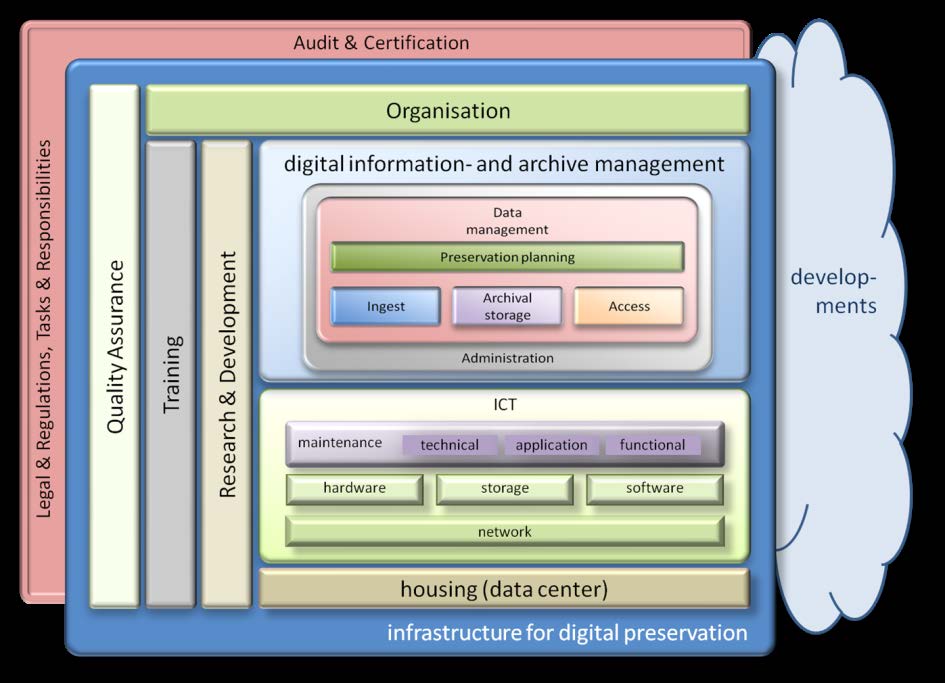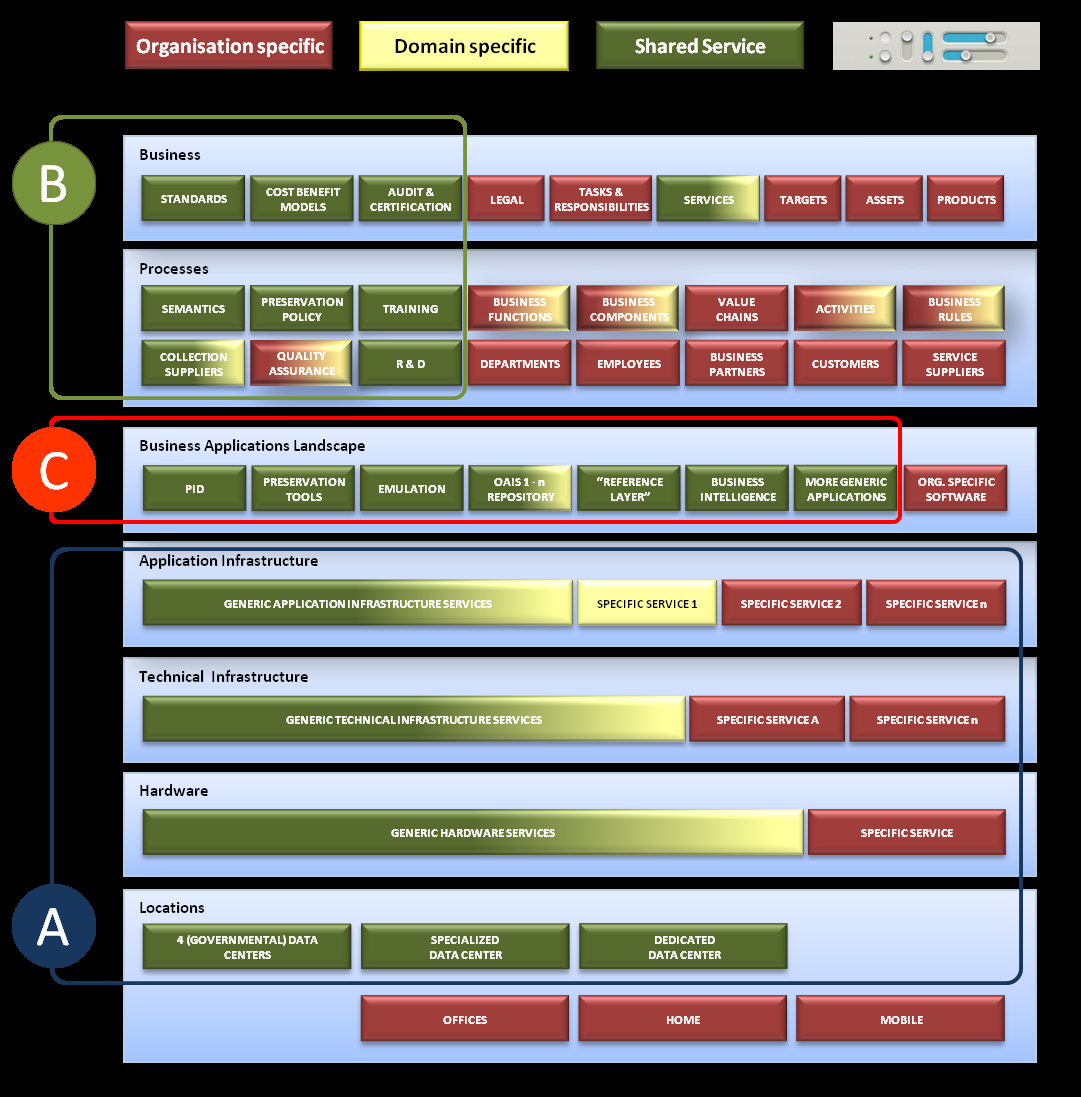Cross-domain collaboration lies at the heart of approach of the Dutch National Coalition for Digital Preservation (NCDD) for the formation of a national shared infrastructure for Digital Preservation. Under the motto “Joining forces for our digital memory”, the research project had the purpose to find out what level of differentiation between the domains offers the best balance for efficiency. Without collaboration, inefficiencies loom, while individual institutes continue to expand their digital archives and may be reinventing the same wheel over and over again. This project’s objective was and is to avoid duplication of work, and to avoid wasting time, money, and energy. Economies of scale make it easier for the many smaller Dutch institutes to profit from available facilities, services, and expertise as well. Policy makers can now ponder the question “The same for less money, or more for the same money?”. In the past few years, major steps forward have been taken: operational e-depots have been developed and put to use, much technical knowledge has been obtained, and the first services to third parties were introduced. With this research, the NCDD has presented a practical and down-to-earth framework for all parties involved, providing a clear picture of what such nationwide infrastructure might look like, including its scalability, and various growth models, culminating in the steps we need to take, in both the short and long term, to achieve this. The research commissioned by NCDD was conducted in three phases: - Desk Research - Fieldwork - Scenarios
PHASE 1: DESK RESEARCH:
A working definition of “infrastructure” was established, including technology hardware, software and, crucially, the organisational facilities surrounding that technology.
This resulted in the following analytical framework for an infrastructure, as used in this research:

The SECOND PHASE of the research involved fieldwork. Extensive interviews with representatives of a number of large institutes, among them NCDD coalition partners, provided insight in the state of the current infrastructure and helped to sketch out a common vision for a desirable future situation. Current facilities, often controlled by individual institutes, were discussed in detail, as well as the possibilities to share facilities and services with third parties. These interviews gave us a detailed picture of the possibilities for collaboration as well as domain specific services needing an individual approach.

Black – gray bars: refer to the current situation, coloured bars: refer to the preferable future situation E.g.: black: is done at national level at present, green: could be done at national level.
For one group of elements, the “Support of the primary process of digital preservation”, the results look like this:

For all groups of elements of the defined infrastructure a concrete picture emerges of which infrastructural elements could be shared, which is a key factor in creating an organisational and technical infrastructure at the national level for sustained access without unnecessary overlaps. It might be better to speak of a network of nationwide facilities, as large parts of this national infrastructure have already been realised. An entirely new infrastructure from scratch is not necessary. Instead, existing facilities can be shared and opened up to third parties. In this way, a network of facilities will gradually evolve and materialise. The central tenet of this research project (and of the NCDD as a whole) is that collaboration will increase effectiveness and efficiency. The aim is to allow every organisation in the Netherlands using digital archives to render their digital objects accessible, and to keep them that way, at the lowest possible cost. Through economies of scale the cost efficiency of work can be greatly enhanced.
Finally, in the third phase of our research, based on the analytical framework and the field results from the previous two phases, a number of possible scenarios for developing a nationwide infrastructure were explored.
From the various scenarios explored, one preferred scenario for a network of distributed national facilities has emerged. A distinctive feature of this scenario is that organisations retain their own facilities where necessary. Wherever possible, facilities are shared. This scenario provides for three trajectories: - The development of a network of technical facilities. Storage facilities and hardware, among other things, belong to this bottom layer (section A in below diagram); - Assistance and consultation. This involves services like training, research, persistent identifiers, and certification (section B in below diagram); - Distributed applications for digital preservation (section C in below diagram):
This scenario is a growth model in which the three trajectories can operate in parallel. Ultimately, it is aimed at creating a network of facilities capable of substantiating collaboration to fulfil existing needs. As a caveat, the existence of a technical infrastructure (A) is a prerequisite for a distributed network of facilities at the application level (C). Level (B) can run simultaneously with (A) and (C).
The NCDD does not propagate a “one size fits all” solution. Inevitably, a balance will need to be struck between the individual approach, domain-specific collaboration, and cross-domain collaboration. Next steps will indicate what this balance will look like.
CONCLUDING: LIFE AFTER THE PROJECT:
A lot of steps towards the proposed solution have already been taken: - The NCDD started 15 projects, with the results of this research as a basis. - Organisations already seek and implement cooperation on various elements of the proposed scenario.
Sequel to this research: funnelling the demand for services of smaller organisations to an articulated Demand, and relate this to a to be developed “Services Catalogue” of Supply.
At the same time, many action still need to follow, especially in the area of obtaining the right political, organisational and budget support for this. Providing a clear and practical framework in the way this research project has done, on which parties have started creating new collaboration models, is a very important first step in this process.
Find out more:
- NCDD Website (in English): http://www.ncdd.nl/en/
- About the study (in English): http://www.ncdd.nl/en/knowledge-and-advice/ncdd-publications/






























































































































